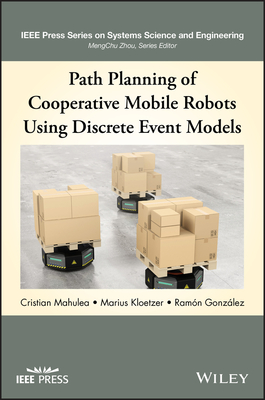Path Planning and Tracking for Vehicle Collision Avoidance in Lateral and Longitudinal Motion Directions
暫譯: 車輛碰撞避免的路徑規劃與追蹤:橫向與縱向運動方向的研究
Ji, Jie, Wang, Hong, Ren, Yue
- 出版商: Morgan & Claypool
- 出版日期: 2020-10-09
- 售價: $1,930
- 貴賓價: 9.5 折 $1,834
- 語言: 英文
- 頁數: 152
- 裝訂: Quality Paper - also called trade paper
- ISBN: 1681739399
- ISBN-13: 9781681739397
海外代購書籍(需單獨結帳)
商品描述
In recent years, the control of Connected and Automated Vehicles (CAVs) has attracted strong attention for various automotive applications. One of the important features demanded of CAVs is collision avoidance, whether it is a stationary or a moving obstacle. Due to complex traffic conditions and various vehicle dynamics, the collision avoidance system should ensure that the vehicle can avoid collision with other vehicles or obstacles in longitudinal and lateral directions simultaneously. The longitudinal collision avoidance controller can avoid or mitigate vehicle collision accidents effectively via Forward Collision Warning (FCW), Brake Assist System (BAS), and Autonomous Emergency Braking (AEB), which has been commercially applied in many new vehicles launched by automobile enterprises. But in lateral motion direction, it is necessary to determine a flexible collision avoidance path in real time in case of detecting any obstacle. Then, a path-tracking algorithm is designed to assure that the vehicle will follow the predetermined path precisely, while guaranteeing certain comfort and vehicle stability over a wide range of velocities. In recent years, the rapid development of sensor, control, and communication technology has brought both possibilities and challenges to the improvement of vehicle collision avoidance capability, so collision avoidance system still needs to be further studied based on the emerging technologies.
In this book, we provide a comprehensive overview of the current collision avoidance strategies for traditional vehicles and CAVs. First, the book introduces some emergency path planning methods that can be applied in global route design and local path generation situations which are the most common scenarios in driving. A comparison is made in the path-planning problem in both timing and performance between the conventional algorithms and emergency methods. In addition, this book introduces and designs an up-to-date path-planning method based on artificial potential field methods for collision avoidance, and verifies the effectiveness of this method in complex road environment. Next, in order to accurately track the predetermined path for collision avoidance, traditional control methods, humanlike control strategies, and intelligent approaches are discussed to solve the path-tracking problem and ensure the vehicle successfully avoids the collisions. In addition, this book designs and applies robust control to solve the path-tracking problem and verify its tracking effect in different scenarios. Finally, this book introduces the basic principles and test methods of AEB system for collision avoidance of a single vehicle. Meanwhile, by taking advantage of data sharing between vehicles based on V2X (vehicle-to-vehicle or vehicle-to-infrastructure) communication, pile-up accidents in longitudinal direction are effectively avoided through cooperative motion control of multiple vehicles.
商品描述(中文翻譯)
在近年來,連接與自動化車輛(CAVs)的控制因各種汽車應用而受到強烈關注。CAVs的一個重要特徵是避免碰撞,無論是靜止的還是移動的障礙物。由於複雜的交通條件和各種車輛動態,碰撞避免系統應確保車輛能夠同時在縱向和橫向方向上避免與其他車輛或障礙物的碰撞。縱向碰撞避免控制器可以通過前方碰撞警告(FCW)、煞車輔助系統(BAS)和自動緊急煞車(AEB)有效地避免或減輕車輛碰撞事故,這些技術已在許多汽車企業推出的新車中商業應用。然而,在橫向運動方向上,必須在檢測到任何障礙物的情況下實時確定靈活的碰撞避免路徑。接著,設計了一種路徑追蹤演算法,以確保車輛能夠精確地遵循預定路徑,同時在廣泛的速度範圍內保證一定的舒適性和車輛穩定性。近年來,傳感器、控制和通信技術的快速發展為提高車輛碰撞避免能力帶來了可能性和挑戰,因此碰撞避免系統仍需基於新興技術進一步研究。
在本書中,我們提供了傳統車輛和CAVs當前碰撞避免策略的綜合概述。首先,本書介紹了一些可以應用於全球路徑設計和局部路徑生成情況的緊急路徑規劃方法,這些是駕駛中最常見的場景。對於傳統演算法和緊急方法在路徑規劃問題中的時間和性能進行了比較。此外,本書介紹並設計了一種基於人工勢場方法的最新路徑規劃方法以進行碰撞避免,並在複雜的道路環境中驗證了該方法的有效性。接下來,為了準確追蹤預定路徑以避免碰撞,討論了傳統控制方法、人類類似控制策略和智能方法,以解決路徑追蹤問題並確保車輛成功避免碰撞。此外,本書設計並應用穩健控制來解決路徑追蹤問題,並驗證其在不同場景中的追蹤效果。最後,本書介紹了AEB系統的基本原理和測試方法,以實現單一車輛的碰撞避免。同時,通過利用基於V2X(車對車或車對基礎設施)通信的車輛之間數據共享,通過多輛車的協作運動控制,有效避免了縱向方向上的連環碰撞事故。

























